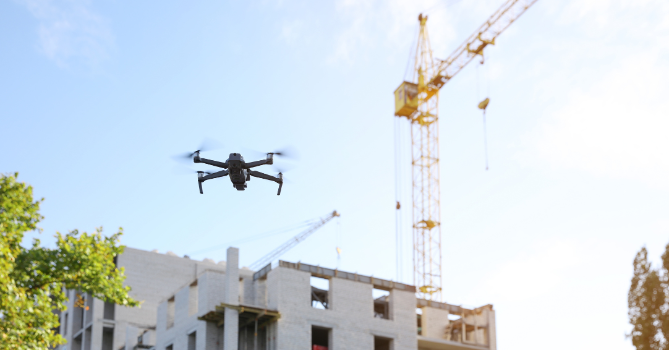.png)
AI in Construction Monitoring: Role and Benefits
Introduction
Construction monitoring has come a long way with technology advancements. Today, Artificial Intelligence (AI) is changing how projects are tracked and managed. Traditional methods rely on manual processes that often lead to errors and delays. In contrast, AI provides real-time insights and accurate data to streamline workflows.

With AI, construction teams can identify potential issues before they escalate, saving time and money. This technology not only reduces human error but also enhances safety by monitoring site conditions. Ultimately, AI in construction monitoring is revolutionizing project management by offering smarter, faster solutions.
The Role of AI in Construction Monitoring
AI plays a crucial role in construction monitoring by providing real-time analysis of massive data sets. This technology can track project progress, safety compliance, and overall site conditions. For instance, AI uses machine learning to analyze images from cameras or drones to detect potential hazards, like misplaced materials or unsafe worker behavior.

AI also helps predict project outcomes. By analyzing historical data, it can foresee delays, cost overruns, or resource shortages. This predictive capability allows project managers to adjust plans and avoid costly setbacks.
Another key function is automating reports. Traditional reporting can be time-consuming and prone to errors, but AI streamlines this process, delivering accurate and up-to-date insights. It gathers and organizes data from various sources—sensors, IoT devices, and construction management software—into easy-to-understand formats.

Overall, AI significantly enhances decision-making. With real-time data and predictive insights, construction teams can work smarter, not harder. They can identify trends, foresee risks, and optimize resources. This proactive approach leads to better project outcomes, fewer disruptions, and improved safety. AI is not just a tool; it’s a strategic partner in the construction industry’s evolution toward smarter project management.
Benefits of AI in Construction Monitoring
AI brings numerous benefits to construction monitoring, making it a valuable asset for project teams. One of the most significant advantages is improved data accuracy. With AI, construction sites can be monitored using automated systems that collect and analyze data in real time. This reduces human error and ensures more reliable information.

AI also boosts decision-making by delivering actionable insights. Project managers can spot trends, predict potential issues, and optimize resources. This proactive approach leads to smarter decisions and fewer disruptions.
Cost and time savings are another key benefit. AI can automate repetitive tasks like scheduling or report generation, freeing up the team to focus on more strategic activities. This increases efficiency and reduces project costs.
AI also enhances site safety. Using cameras and sensors, AI can detect unsafe conditions or behaviors and alert the team immediately. This real-time monitoring helps prevent accidents and ensures compliance with safety standards.
Lastly, AI supports sustainable construction. By tracking energy usage and resource allocation, AI helps teams reduce waste and implement eco-friendly practices. In summary, AI provides improved accuracy, better decision-making, enhanced safety, and cost efficiency, transforming how construction projects are monitored and managed.
AI and BIM Integration for Monitoring
AI and BIM integration creates a smarter, more efficient construction monitoring system. BIM models provide a visual representation of a project’s physical and functional characteristics, while AI analyzes real-time data to identify patterns, predict outcomes, and optimize resources. This combination allows project teams to track progress and manage changes within a single platform.

With AI-enhanced BIM, teams can visualize updates and potential risks, such as schedule delays or resource shortages, directly in the 3D model. This level of integration enables better collaboration between stakeholders and ensures that everyone stays informed. AI can even automate tasks like updating the BIM model based on site conditions, reducing manual effort and minimizing errors.
Moreover, AI helps teams foresee and address potential issues before they escalate, reducing rework and delays. By aligning AI’s predictive capabilities with BIM’s detailed visualization, construction projects benefit from enhanced accuracy, efficiency, and overall project quality.
Future of Construction Monitoring with AI
The future of construction monitoring with AI is set to transform the industry further. Emerging technologies like drones, IoT sensors, and AI-powered cameras will provide even more detailed, real-time data on project sites. AI will be capable of autonomous monitoring, detecting safety hazards, and generating insights without human intervention. Additionally, AI’s ability to learn and adapt will enable predictive maintenance and equipment management, reducing downtime and increasing efficiency. This integration of AI in construction monitoring will lead to smarter, safer, and more efficient project delivery.
Conclusion
AI is revolutionizing construction monitoring by providing real-time insights, predictive analytics, and automation. It minimizes errors, enhances safety, and improves project efficiency. When combined with BIM, AI offers a powerful tool for managing complex projects with greater precision and control. As the technology evolves, AI will continue to drive the industry towards smarter, more sustainable practices. Embracing AI in construction monitoring today means laying the foundation for a more efficient, data-driven future in the construction sector.